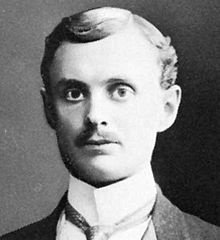Charles Rolls
The Hon. Charles Stewart Rolls (born August 27, 1877 in Berkeley Square, London , † July 12, 1910 in Bournemouth ) was the founder of the Rolls-Royce automobile company with Frederick Henry Royce .
C. S. Rolls was born in London to the 1st Baron Llangattock. He studied at Eton College and Trinity College , Cambridge and has been interested in engines since his youth. Rolls merged with Frederick Henry Royce and founded the Rolls-Royce automobile factory in 1904. Rolls was in charge of business, Royce was in charge of technology.
Rolls was also a pioneer in aviation, becoming the second Briton to receive a flying license from the Royal Aero Club . On December 26, 1908, he demonstrated the possibilities of balloon flight. He started with the Mercury balloon with four other people (including his mother, Lady Llangattock) in Monmouth . He landed on the lawn in front of his parents' house; after dinner he rose again. After crossing a mountain range, he landed in Blaenavon . On landing, all the ropes on the balloon were frozen. On June 2, 1910, he was the first to fly non-stop over the English Channel “there and back”. Six weeks later, Rolls died in a plane crash over Bournemouth.
The crash
Rolls' plane (built by the Wright brothers ) crashed when its rear part broke off. Rolls was the eleventh pilot to die in an airplane accident and the first British.
The London Times , in its July 13, 1910 issue, described in great detail the crash of C. S. Rolls in a precision flying competition on the outskirts of Bournemouth. Rolls had already flown a competition lap in his double-decker that morning, but landed 24 meters further from the target than a competitor (13 meters). At 12:25 p.m. Rolls took off again:
"The machine was about 50 feet [approx. 15 meters] above the ground when the left side of the stern broke off along with the left part of the rudder. Immediately the sound of wood splintering could be heard. Thousands of spectators saw what had happened, and the silence of terror spread over the crowd as the machine turned sharply towards the ground and back, now flying on its back. In this position, the biplane hit the ground from a height of 30 to 40 feet. The crash was horrific and was immediately followed by a loud noise - the engine exploding. It was immediately clear that if Mr. Rolls wasn't dead immediately, he must have been seriously injured. The first to reach the scene of the accident found Mr. Rolls lying next to the machine. He didn't seem to have sustained any serious cuts. When they picked him up to lay him on a board, it appeared that he had moved for a moment. So resuscitation attempts began. When Dr. Hardy came and was given ether. However, that was a lost hope. The doctor said that death was probably caused by the bruises on impact. The signal sounded, the competition was not continued. "
Web links
Individual evidence
- ↑ Flight, January 2, 1909, p. 5
| personal data | |
|---|---|
| SURNAME | Rolls, Charles |
| ALTERNATIVE NAMES | Rolls, Charles Steward |
| BRIEF DESCRIPTION | British entrepreneur and co-founder of the Rolls-Royce automobile company |
| DATE OF BIRTH | August 27, 1877 |
| PLACE OF BIRTH | Berkeley Square, London |
| DATE OF DEATH | July 12, 1910 |
| Place of death | Bournemouth |


